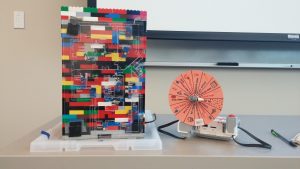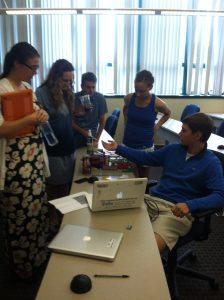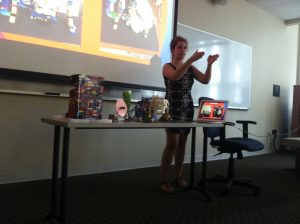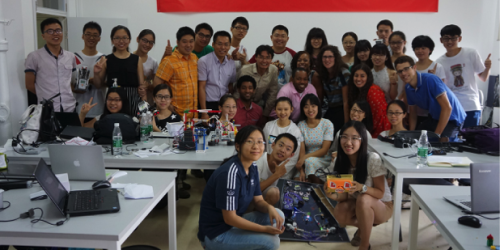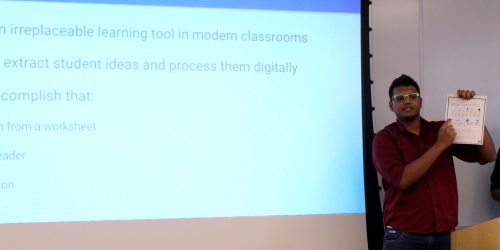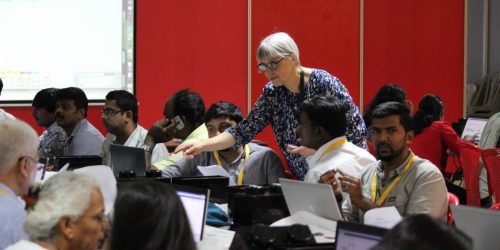By Devyn Curley
From July 6th to July 31st six high school students participated in the Robo-Hacking Internship at Tufts CEEO. The goal of the internship was to expose students to a variety of technologies, encouraging exploration through hands on projects with a robotics focus. During this four week program, the first week and a half was spent on short projects, each focusing on a different technology. This provided a landscape for the interns to refer to when selecting and completing their large scale project over the final two and half weeks. In addition to hard skills, the interns honed their critical thinking and troubleshooting abilities as they worked through their final projects.
Exploration of Technologies
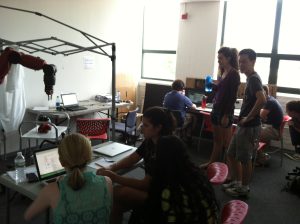
In addition to a wealth of technologies, the first days of the program introduced the interns to others working in the center as well. They began by working on various EV3 projects where they learned LabVIEW, which ended up being vital to their projects. Their 3D printing project had real life application as they were tasked with designing new keychains for the bathroom key in TinkerCAD. Andy and Jason came in to guide the interns through myRIO tutorials they had been working on, and Kerrianne took time to help each intern laser cut their own designs made in Adobe Illustrator. The high school students also spent time in the mechanical engineering lab designing with SolidWorks and had fun exploring uses of the 3D Doodler, the Leap Motion sensor, and even played a video game using Makey Makey. The fan favorite project was programming Baxter to pick up a teddy bear and wave using ROS on LabVIEW with Whitney.
“I learned a lot about new technology that I would not have had access to without the CEEO. The challenges I conquered will be useful for me as a future engineer… this unique experience has nourished my engineering skills, especially my ability to program.”
Final Projects
Going into the second half of the program, students assembled project proposals for a problem they wanted to solve. Janki noticed how easy it was to get lost in the CEEO, so she laser cut a map of the center to mount onto a LEGO brick robot to act as an interactive directory, give verbal instructions to users and lighting up their destination on the map using LEDs and a myRIO (seen right). Madison wanted her project to reflect her interest in education, so she 3D printed a LEGO compatible human skull that would inform students about a specific part of the head when touched. Hadleigh, who needed to leave after two weeks, quickly assembled a prototype for an automatic goat feeder using the LEGO NXT, designed to feed her goats a specific amount twice a day when her family is away from home.
Some interns chose to base their project around using an existing technology in a new, unique way. Phil tackled the challenge of using the NXT as a 3D scanner, generating 3D plots of various objects in LabVIEW (seen left) using a touch sensor to collect points. Kevin was very interested in EEG (electroencephalogram) sensors, and chose to program an EV3 car that he could control with his mind based on his level of attentiveness. He utilized Jess Scolnic’s EVDuino shield and worked closely with her on the project. Finally, Kelli decided to explore Strawbees: small plastic parts that connect straws in intricate ways. Her project compared building with Strawbees and other materials which led her to design her own straw connectors to use in an NXT bike made out of straws.
“This whole exploration taught me that if you don’t like the way something works or is made, you can create your own, better version.”
Final Presentation and Reflections
The two and a half weeks of project work culminated in a presentation for the entire CEEO. They worked well through the stressful days leading up to it, and handled technical difficulties during their presentation very well. After the presentations, interns enjoyed answering questions for small groups, giving more detailed answers about their projects, and even letting having audience members interact with them. After the presentation, interns were asked to write down a reflection on their experience the past four weeks, what they learned, and what challenges they faced. The quotes throughout this article are from those reflections, two of which summarizing the biggest take-aways are below.
“We learned how to work together, help each other out, and figure out different technologies together. I grew a lot during this experience because I now know that it takes a lot of time and planning to create a successful project.”
“At the beginning of the first week here I was not comfortable programming, but now I feel confident with my programming skills for future challenges as an engineer. I learned from my fellow interns… we all tried to help each other, and I worked through the challenges along with my fellow interns, understanding more than just the technology I used in my final project.”

